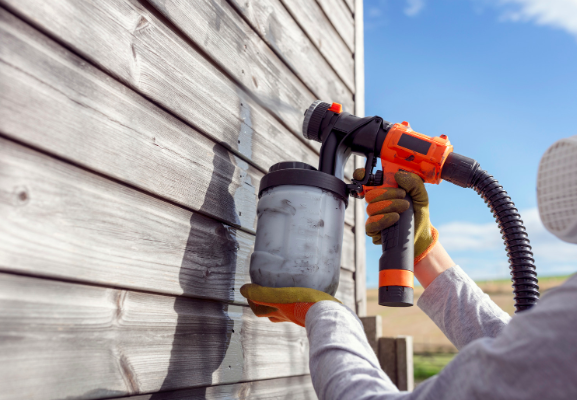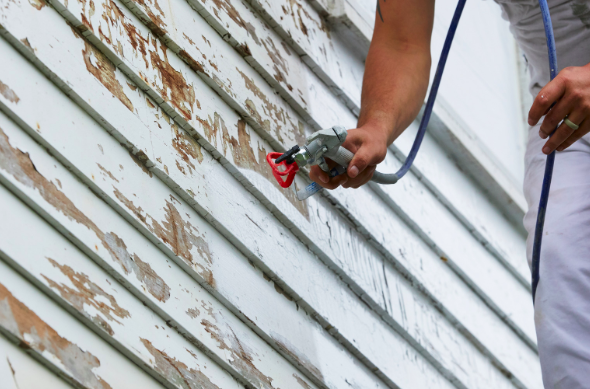Last Updated on November 25, 2022 by mdmtool
There are two main types of paint sprayers that you can use – airless and air paint sprayers. Both have their advantages and disadvantages. Airless paint sprayers are ideal for large projects where you need to quickly cover a lot of surface area. They’re also great for painting in difficult-to-reach places, like high ceilings or behind cabinets. Air paint sprayers are better suited for smaller projects and more delicate work, like painting furniture or trim.
What Is An Air Paint Sprayer?

Airless paint sprayers are paint spraying equipment that doesn’t use compressed air to operate. Instead, an airless paint sprayer uses a high-pressure pump to force the paint through the nozzle. This makes them ideal for large jobs where you need to quickly cover a lot of surface area.
What Is An Airless Paint Sprayer?

Air paint sprayers use compressed air to operate. The compressed air helps to atomize the paint, making it easier to apply evenly to surfaces. Air paint sprayers are typically used for smaller jobs, as they can be more challenging to control than airless paint sprayers. An airless paint sprayer is probably your best bet if you need to cover a large area quickly.
Difference Between Airless And Air Paint Sprayer

- Transfer Rate: The airless paint sprayer has a higher transfer rate than the air paint sprayer. This means less paint is wasted, and less cleanup is required.
- Paint Finish: The most obvious difference between an airless and an air-paint sprayer is the finish of the paint job. An airless paint sprayer will give you a much smoother, more even coat of paint than an air paint sprayer. An airless paint sprayer does not rely on compressed air to atomize the paint into tiny droplets. Instead, an airless paint sprayer uses a high-pressure pump to force the color through a small tip at a very high velocity.
- Material Viscidity: Airless paint sprayers can handle a range of viscosities, from latex paints to heavier coatings like acrylics, urethanes, or epoxies. Air-powered paint sprayers typically require thinning the material to be sprayed for proper atomization.
- Application Use: Airless paint sprayers are commonly used for projects like painting a house’s exterior. These projects require a lot of material to be sprayed relatively quickly. Airless paint sprayers can also be used for other large projects, such as painting a fence or deck. On the other hand, air paint sprayers are typically used for smaller projects, like painting a piece of furniture. Air paint sprayers can also be used for touch-ups or other small jobs.
- Pressure: The pressure at which the paint is delivered from an airless sprayer to the surface is about three times higher than that of an air paint sprayer. This means using an airless sprayer can cover a larger area in a shorter time.
- Viscosity: Paint sprayers either use air or don’t use air. Airless paint sprayers don’t require an air compressor, while air paint sprayers do. This is the significant difference between the two types of paint sprayers.
- Safety measures: Airless paint sprayers are generally considered much safer than air paint sprayers. This is because they don’t release any harmful chemicals or fumes into the air, and they don’t require any ventilation.
- The scale of Operation: Airless paint sprayers are built for larger-scale painting projects. If you need to cover a large area quickly, then an airless paint sprayer is the best option. On the other hand, if you’re working on a smaller project, an air paint sprayer will suffice.
Tips for Using the Air Paint Sprayers and Airless Paint Sprayers
Air Paint Sprayers:
- To ensure an even paint job, keep the paint sprayer moving.
- Start and end each stroke beyond the area you are painting to avoid creating a build-up of paint at the start or end of each stroke.
- When using latex paint, thinning may be necessary. Check the manufacturer’s instructions to determine the correct ratio of paint to water.
- If painting a large area, work in small sections to avoid overloading the paint sprayer.
- To clean the air paint sprayer, disassemble all parts and wash them with soapy water. Rinse thoroughly and allow to air dry.
Airless Paint Sprayers:
- Hold the airless paint sprayer consistently from the surface to avoid over or under-spraying.
- Keep the airless paint sprayer moving to avoid creating a paint build-up.
- Paint in small sections to avoid overloading the paint sprayer.
- To clean the airless paint sprayer, disassemble all parts and wash them with soapy water. Rinse thoroughly and allow to air dry.
Should You Choose An Air Sprayer Or An Airless Sprayer?
Although they both serve the same purpose of spraying paint, airless and air sprayers differ in many ways. If you’re unsure which type of sprayer is right for your project, consider the following factors:
- The material you’ll be spraying: Airless sprayers can handle thicker materials, while air sprayers work best with thinner materials.
- The surface you’ll be spraying: Airless sprayers are better for rough surfaces, while air sprayers provide a more even finish on smooth surfaces.
- The speed of your project: Airless sprayers can cover a larger area more quickly, while air sprayers provide more control for detailed work.
- The price: Airless sprayers are typically more expensive than air sprayers.
Pros And Cons Of Airless Spray
Pros:
- Airless paint sprayers can achieve a professional finish much faster than traditional methods like brushes or rollers.
- They are also ideal for painting large surfaces, such as walls and ceilings.
- Airless paint sprayers operate at high pressure, which atomizes the paint into very fine droplets. This results in an even coating with fewer brushstrokes.
- Airless paint sprayers are also less likely to cause overspray, making them more efficient and less waste.
Cons:
- Airless paint sprayers can be expensive, so they may not be a practical choice for small projects.
- They also require some training to use correctly, so you may need to practice before tackling a more significant job.
- If not used correctly, airless paint sprayers can produce a messy, uneven finish.
- You will also need to wear protective clothing and equipment when using an airless paint sprayer, as the paint droplets can be harmful if inhaled or ingested.
Pros And Cons Of Air Paint Sprayer
Pros
- They are very versatile and can be used for various big and small projects.
- Airless paint sprayers are also much faster than their airbrush counterparts, so if you’re working on a larger project, they can save you a lot of time.
- Another advantage of airless paint sprayers is that they can provide a more even coat of paint, which is ideal for projects that require a professional finish.
- Airless paint sprayers are generally easier to clean than airbrush paint sprayers.
Cons:
- One downside of airless paint sprayers is that they can be a bit more expensive than airbrush paint sprayers.
- Another potential downside is that they can be more difficult to control than airbrush paint sprayers, so if you’re not experienced in using them, you may want to practice on a smaller project first.
- Airless paint sprayers use high pressure to atomize the paint.
FAQs
Does Airless Sprayers Use More Paint Than Conventional Sprayers?
No, airless paint sprayers use less paint than traditional methods like brushes and rollers.
How do airless sprayers prevent overspray?
An airless paint sprayer is equipped with a tip guard that helps to prevent overspray. This guard surrounds the sprayer’s tip and deflects the paint mist away from the surface, preventing it from spreading beyond the intended area.
Does an airless paint sprayer need a compressor?
Airless paint sprayers do not require a compressor; they rely on high pressure to force the paint through the nozzle.
What is the cost of purchasing an airless paint sprayer?
Airless paint sprayers are more expensive than air paint sprayers. They range in price from about $200 to $600, depending on the model and brand.
Conclusion
Paint spraying is a fast and efficient way to paint large surfaces. It is also a great way to achieve a smooth, even finish. There are two main paint sprayers: airless and air paint sprayers. Airless paint sprayers use high-pressure pumps to atomize the paint into very fine droplets. This results in a very smooth finish. On the other hand, air sprayers use compressed air to atomize the paint. This results in a rougher finish.





